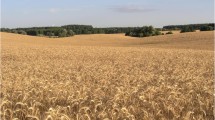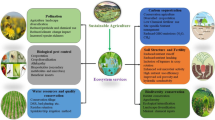Abstract
Previous studies have shown there is a wide spectrum of incipient management practices between gathering and agriculture, that include resources commonly considered “wild.” Based on the study of 20 species used as foodstuffs in the community of Santa María Tecomavaca (Mexico), we evaluated nonagricultural management forms such as gathering, incipient nonselective management, incipient selective management and occasional ex situ cultivation to learn if they represent a gradient in the intensity of manipulation of a resource. The way in which the intensity of manipulation of a resource can vary as a function of cultural importance and the species’ biology was also analyzed. Using an index that measures the intensity of management of a resource, it has been established that the degree of intensity depends on: the specialization of the practices directed to the environment as well as to the individuals; the number of persons performing these practices; and the number of different practices taking place. The degree of management intensity is also a consequence of the joint action of cultural importance and of species’ biology.



Similar content being viewed by others
Notes
Items 3–6 were qualitatively evaluated.
References
Arellano, E., and Casas, A. (2003). Morphological Variation of Escontria chiotilla (Cactaceae) under Silvicultural Management in the Tehuacán Valley, Central México. Genetic Resources and Crop Evolution 50: 439–453.
Bye, R. (1993). The role of humans in the diversification of plants in México. In Ramamoorthy, T. P., Bye, R. A., Lot, A., and Fa, J. (eds.), Biological diversity of Mexico origins and distribution, Oxford University Press, Oxford, pp. 707–731.
Caballero, J. (1987). Etnobotánica y desarrollo: la búsqueda de nuevos recursos vegetales. In Toledo, V. M. (ed.), Proceedings of IV Congreso Latinoamericando de botánica: Simposio de Etnobotánica, perspectivas en Latinoamérica, Medellín, Colombia, June 29–July 5, 1986, Universidad de Antioquia, Universidad Nacional de Colombia, Asociación colombiana para el avance de la ciencia, Asociación Latinoamericana de Botánica, Academia Colombiana de Ciencias Exactas, Físicas y Naturales, pp. 79–96.
Caballero, J. (1991). Use and management of Sabal palms among the Maya of Yucatan: A case of technological innovation based on the folk biological knowledge. In Rhoades, R. E., Sandoval, V. N., and Bagalanon, C. P. (eds.), Best paper awards 1990. International Potato Center and User’s Perspective with Agricultural Research and Development, pp. 13–23.
Caballero, J. (1992). The Maya Homegardens of the Yucatan Peninsula: Past, Present and Future. Ethnoecologica 1(1): 35–54.
Caballero, J. (1993). El caso del uso y manejo de la palma de guano (Sabal spp.) entre los mayas de Yucatán México. In Leff, E., and Carabias, J. (eds.), Cultura y manejo sustentable de los recursos naturales, Centro de Investigaciones Interdisciplinarias en Humanidades UNAM, México, pp. 203–248.
Caballero, J. (1994). Use and management of Sabal palms among the Maya of Yucatán. PhD Dissertation. California University at Berkeley, USA.
Caballero, J., and Mapes, C. (1985). Gathering and Subsistence Patterns among the Purepecha of Patzcuaro, México. Journal of Ethnobiology 5(1): 31–34.
Caballero, J., and Cortés, L. (2001). Percepción, uso y manejo tradicional de los recursos vegetales en México. In Rendon, B., Caballero, J., and Martínez-Alfaro, M. A. (eds.), Plantas Cultura y Sociedad, Universidad Autónoma Metropolitana, SEMARNAP, México, pp. 79–100.
Casas, A., Vasquez, M. C., Viveros, J. L., and Caballero, J. (1996). Plant Management among the Nahua and the Mixtec in the Balsas River Basin, México: An Ethnobotanical Approach to the Study of Plant Domestication. Human Ecology 24(4): 455–478.
Casas, A., Caballero, J., Mapes, C., and Zarate, S. (1997a). Manejo de la vegetación, domesticación de plantas y origen de la agricultura en mesoamerica. Boletín de la Sociedad Botánica de México 61: 17–31.
Casas, A., Pickersgill, B., Caballero, J., and Valiente-Banuet, A. (1997b). Ethnobotany and Domestication in Xoconochtli Stenocereus stellatus (Cactaceae) in the Tehuacán valley and la Mixteca Baja, México. Economic Botany 51(3): 279–292.
Casas, A., Valiente-Banuet, A., and Caballero, J. (1998). La domesticación de Stenocereus stellatus (Pfeiffer) Ricobono (Cactaceae). Boletín de la Sociedad Botánica de México 62: 129–140.
Casas, A., Caballero, J., and Valiente-Banuet, A. (1999a). Procesos de domesticación en cactaceas columnares de la vertiente del Pacífico sur de México. In Pimienta, B. E. (ed.), El pitayo en Jalisco y especies afines en México, Universidad de Guadalajara, Fundación Jalisco produce, Guadalajara, pp. 147–234
Casas, A., Caballero, J., and Valiente-Banuet, A. (1999b). Use, Management and Domestication of Columnar Cacti in South-central México: A Historical Perspective. Journal of Ethnobiology 19(1): 71–95.
Casas, A., Caballero, J., Valiente-Banuet, A., Soriano, J. A., and Dávila, P. (1999c). Morphological Variation and the Process of Domestication of Stenocereus stellatus (Cactaceae) in Central México. American Journal of Botany 86(4): 522–533.
Casas, A., Valiente-Banuet, A., Viveros, J. L., Caballero, J., Cortés, L., Dávila, P., Lira, R., and Rodriguez, I. (2001). Plant Resources of the Tehuacán-Cuicatlán Valley, México. Economic Botany 55(1): 129–166.
Colunga, P. (1984). Variación morfológica, manejo agrícola y grados de domesticación de Opuntia spp. en el bajío guanajuatense. M. en C. Dissertation. Colegio de Posgraduados de Chapingo, Chapingo, México.
Colunga, P., Hernandez-Xolocotzi, E., and Castillo, A. (1986). Variación morfológica, manejo agrícola tradicional y grado de domesticación de Opuntia spp. en el bajío Guanajuatense. Agrociencia 65: 7–44.
Cruz, M., and Casas, A. (2002). Morphological variation and reproductive biology of Polaskia chende (Cactaceae) under domestication in central México. Journal of Arid Environment 51: 561–576.
De Wet, M. J., and Harlan, J. R. (1965). Weeds and Domesticates: Evolution in the Man-made Habitat. Economic Botany 29(2): 99–107.
Grupo Mesófilo (2001). Ordenamiento territorial Santa María Tecomavaca. Teotitlán, Oaxaca. Etapa 1: Diagnóstico y Sistematización de la información comunitaria. Internal Document of work. Comisariado Municipal Santa María Tecomavaca, estado de Oaxaca, México.
Harlan, J. R. (1975). Crops and Man, American Society of Agronomy, Madison, Wisconsin.
Hillman, G. C., and Davies, M. S. (1996). Measured Rates in Wild Wheats and Barley under Primitive Cultivation and their Archeological Implications. Journal of World Prehistory 4: 157–222.
Instituto Nacional de Estadística, Geografía e Informática (INEGI) (2001), Censo General de Población y Vivienda 2000. México.
Ladizinski, G. (1987). Pulse Domestication before Cultivation. Economic Botany 4(1): 60–65.
Lawrence, A., Philips, O. Reategui-Ismodes, A., López, M., Rose, S., Wood, D., and Farfan, A. J. (2005). Local Values for Harvested Forest Plants in Madre de Dios, Peru: Towards a More Contextualized Interpretation of Quantitative Ethnobotanical Data. Biodiversity and Conservation 14: 45–79.
Luna, M. D. C. (1999). Etnobotánica de la pitaya mixteca (Pachyceraceae).PhD Dissertation. Colegio de Posgraduados de Chapingo, Chapingo, México.
Luna, M. D. C., Aguirre, J. R., and Peña-V, C. B. (2001). Cultivares tradicionales mixtecos de Stenocereus stellatus (Cactaceae). Anales del Instituto de Biología, Universidad Nacional Autónoma de México. Serie Botánica 72(2): 131–155.
Martínez-Ballesté, A., Caballero, J., Gama, V., Flores, S., and Martorell, C. (2000). Sustainability of the traditional management of xa’an palms by the lowland Maya of Yucatán, México. In Stepp, J. R., Wyndham, F. S., and Zarger, R. K. (eds.), Proceedings of the Seventh International Congress of Ethnobiology: Ethnobiology and biocultural diversity. Athens, Georgia October 23–27, 2000, International Society of Ethnobiology. Georgia, pp. 381–388.
Rohlf, F. J. (2000) NTSYS-PC version 2.11H: Numerical taxonomy and multivariate analysis system, Exeter Publishing Ltd., Seuket, New York.
Pieroni, A. (2001) Evaluation of the Cultural Significance of Wild Food Botanicals Traditionally Consumed in Northwestern Tuscany, Italy. Journal of Ethnobiology 21(1):89–104.
Philips, O., and Gentry, A. H. (1993a). The Useful Plants of Tambopata, Peru: I. Statistical Hypothesis Test with a New Quantitative Technique. Economic Botany 47(1): 15–32.
Philips, O., and Gentry, A. H. (1993b) The Useful Plants of Tambopata, Peru: II: Additional Hypothesis Testing in Quantitative Ethnobotany. Economic Botany 47(1): 33–43.
Zohary, D., and Hopf, M. (1993). Domestication of Plants in the World. The Origin and Spread of Cultivated Plants in West Asia, Europe and the Nile Valley, Clarendon, Oxford.
Acknowledgments
This research was supported by The National Council of Science and Technology of México CONACYT through Project G35450-V, “Los Recursos Vegetales del Valle de Tehuacán-Cuicatlán desde una Perspectiva Etnobotránica.” Special gratitude is expressed to the Santa María Tecomavaca community for their hospitality and help.
Author information
Authors and Affiliations
Corresponding author
Rights and permissions
About this article
Cite this article
González-Insuasti, M.S., Caballero, J. Managing Plant Resources: How Intensive Can it be?. Hum Ecol 35, 303–314 (2007). https://doi.org/10.1007/s10745-006-9063-8
Published:
Issue Date:
DOI: https://doi.org/10.1007/s10745-006-9063-8




